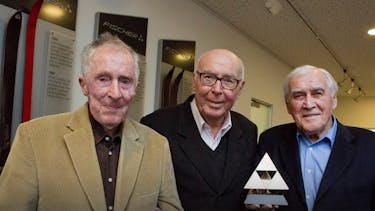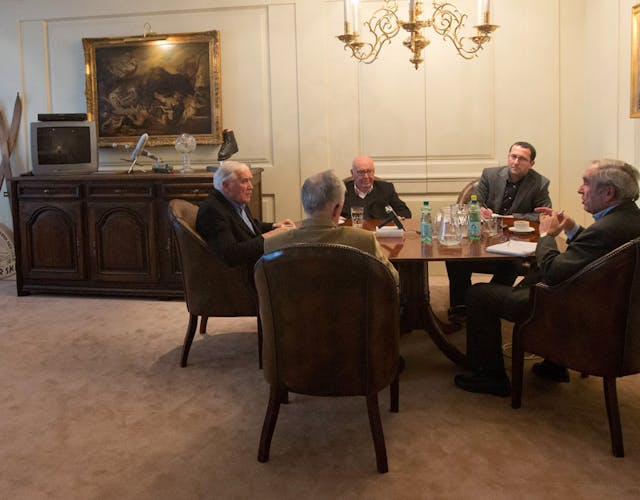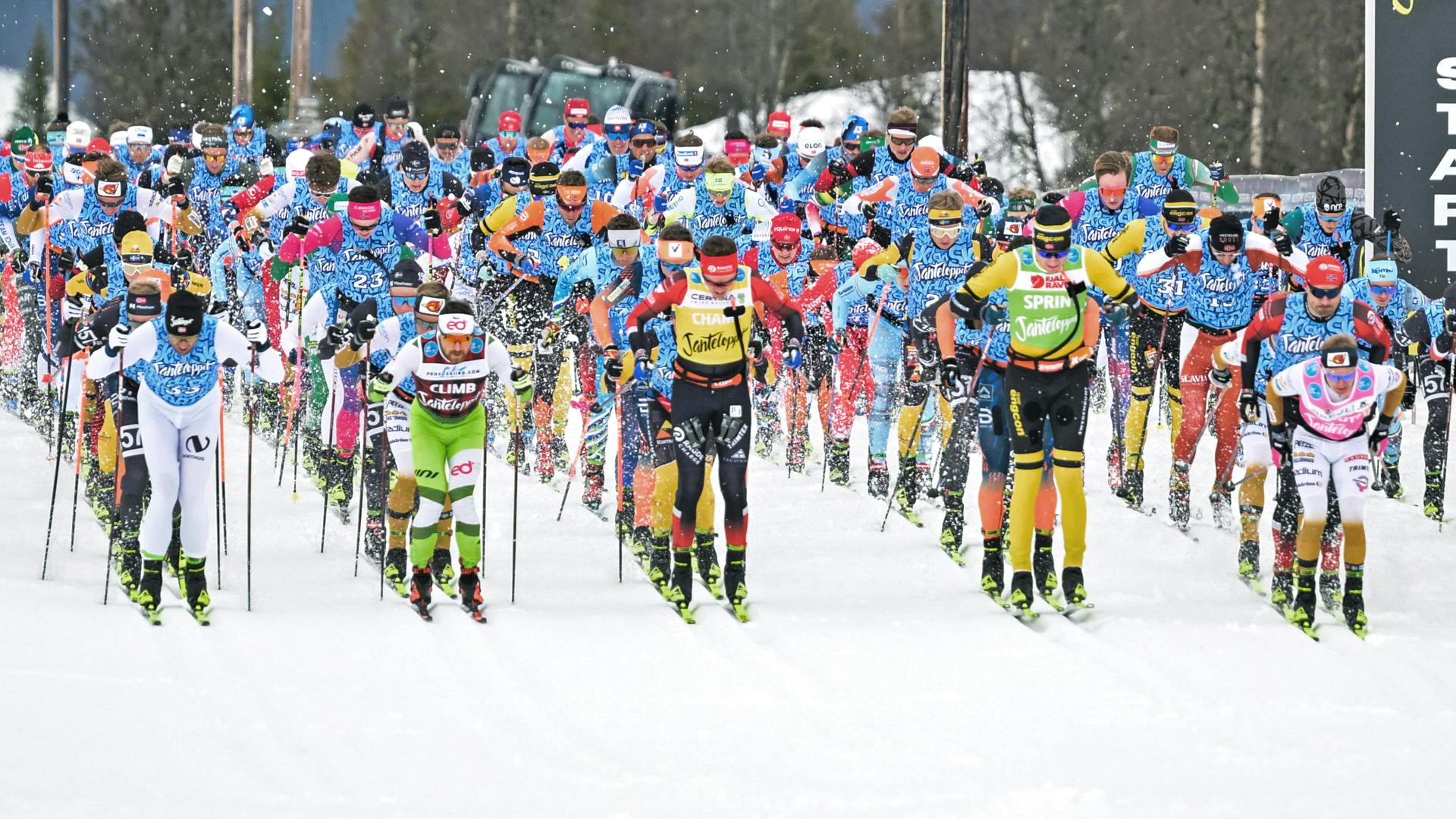„I WAS PRIVILEGED TO EXPERIENCE INDUSTRIAL HISTORY IN THE MAKING – IN FAST MOTION.”
For many years the company’s fortunes were in their hands: Josef Fischer, born in 1929, Ernest Simharl, born in 1925, and Rudolf Ferch, born in 1930. After his father’s death in 1959 Josef Fischer managed the ski factory and made skiing history with his revolutionary innovations. Ernest Simharl, known as “the Sir”, was originally taken on to handle publicity, but very soon took charge of commercial and organisational management. The designer Rudolf Ferch created not only the Fischer triangle but also legendary skis such as the C4, or the eagle emblem for the Austrian ski pool. On 9 January 2014 the three friends met in Josef Fischer’s company office in Ried to mull over stories about and the history of the Innviertel firm once more.
How did the three of you – Josef Fischer, Ernest Simharl and Rudolf Ferch – originally get together?
FISCHER Ernest Simharl, then a reporter with “Echo der Heimat”, interviewed me for his paper. Then I was in touch with him a bit more, and my impression was, that’s a bright lad – and if I happen to need someone one day I’ll ask him if he might join the company. And then he discovered Rudi Ferch in Linz.
FERCH That was in the spring of 1955. I had just returned from Vienna, was in charge of a so-called master studio at the Art College in Linz and was on the lookout for paid work. Ernest Simharl asked a firm whether they knew someone who one could talk to about commercial art – and they mentioned that someone had just reappeared from Vienna. That’s how we met up.
SIMHARL The first thing you did for us was the Fischer company stationery.
FISCHER And the first leaflet was a pretty narrow affair.
FERCH That’s right, narrow – a DIN A4 sheet folded into three, showing a few skis stood about like pickets for a fence, and that was all.
FERCH The stationery still had the old logo.
FISCHER Drawn by my sister Erna.
You then developed the Fischer triangle from this old logo, Herr Ferch?
FERCH Fischer had a nostalgic logo: a triangle with the Matterhorn, blue sky, a skier and “Fischer Ski” in runic characters, all printed in four colours. We were looking for a simpler symbol, easy to reproduce and also suitable for stamping and embossing. I suggested the pure equilateral triangle as the new Fischer logo.
It’s said that the three triangles symbolise the three of you, Fischer, Simharl and Ferch?
FISCHER Yes, that’s true too.
FERCH That’s what someone read into it later. I didn’t mean it in that way at all. The triumvirate – that was the way people talked in Ried. The new logo was born in the autumn of 1958; for the presentation it was stamped in white on a black ski. Fischer senior was visibly shaken. He wasn’t at all happy with the new symbol, and just said to me: “Now people will think I’ve no money left!”
„Josef was on good terms with almost all the ski manufacturers.”
You took over the company in 1959. Herr Simharl and Herr Ferch joined Fischer in the 1950s. How did the three of you interact in those days?
FERCH Of course there were targets. The entrepreneurial, technical ones,
which Pepi concentrated on. The commercial, organisational ones – they were Ernest’s domain. I looked after design and brand presence. In contrast to your father, Pepi, you were completely focused on technical improvement. And Ernest rescued the ski factory over and over again with his knowledge and skills. Josef Fischer is a fantastic businessman, technically oriented, generous. Ernest Simharl kept the company on an even keel.
FISCHER Yes, without him I couldn’t have afforded to implement my ideas.
FERCH Thanks to our collaboration I was privileged to experience industrial history in the making – in fast motion. The dramatic development, the meteoric rise of the company could have taken generations – here in Ried it was a matter of 20 or 30 years. In the development department pioneering results were achieved that went far beyond the needs of a ski manufacturer. On this basis even aerospace components were fabricated. After all, everything technologically necessary was on hand.
SIMHARL What always fascinated me – we did a lot of travelling together, to all sorts of places – was that Josef Fischer was on good terms with almost all the ski manufacturers. They invited him to visit them, and vice versa. And the fascinating thing was that he noticed things on their premises, and they noticed nothing here.
FISCHER I really spent time in the company every single weekend. Again and again on my rounds I noticed things that could be improved.
FERCH The Fischer ski factory did a fantastic job in development. In Ing. Staufer we had a man from Seibersdorf with a background in nuclear technology – but Josef Fischer could communicate with him. That was a powerful tie-up between trained and intuitive science – that was your great strength.
„Again and again on my rounds I noticed things that could be improved.”
Is there a single event that had a decisive impact on Fischer as a ski manufacturer?
SIMHARL I believe that there was an element of continuity throughout, and that innovation took place. But I’m not sure if you can say that there was one particularly decisive moment in Fischer’s history. There were all sorts of new developments – technical ones due to Josef Fischer, in design due to Rudolf Ferch.
FISCHER And commercially due to Ernest Simharl.
FERCH One moment of greatness in the company’s history does occur to me – the success of a fantastic ski called the C4, with its new appearance typical of Fischer, which in conjunction with Franz Klammer did wonders for the company’s image. That was definitely a highlight, but it’s just a brief moment in our development. Then again, Zimmermann’s victory on metal skis in 1964 was a sensation at the time.
SIMHARL Exactly, that was at least as impressive as the Klammer episode. It was partly a matter of innovations which made a big difference to Fischer, partly the field of design development, and then of course there were victories in races. But I wouldn’t say that they made a spectacular difference to the company’s image.
FISCHER No, not really. It developed very slowly. It was tough for Fischer in racing; the only ones who counted were Kneissl and Kästle and to some extent Blizzard. They made fun of us as plainsmen.
How did Josef Fischer get on with the other ski magnates?
FISCHER Not at all badly. I was on good terms with all of them except for Rohrmoser.
SIMHARL My impression was that Josef Fischer got on very well with almost all the ski manufacturers, never mind whether they were in Austria or elsewhere, for instance with Head, and that envy didn’t really come into it. My impression was that Josef Fischer got on very well with almost all the ski manufacturers, never mind whether they were in Austria or elsewhere, for instance with Head, and that envy didn’t really come into it.
FERCH A really important stage was Zimmermann’s winning on Fischer metal skis, the Alu Steel. Today I can still hear Howard Head’s voice as, just after Egon’s sensational victory on Fischer metal skis, he roared down in the direction of the finish line: “Congratulations, Mr Fischer!” He was a long way off competing in races with his metal skis. This victory did a lot for the image of metal skis – which was good for him, too.
„Fischer was very innovative and creative in its advertising, too.”
FERCH Here’s an example: for the 1964 Olympics we made up a red sticker with the message: “The winner’s ski – Fischer ski”. And when it turned out that the winning ski really was made by Fischer, staff and dozens of students fanned out and stuck these stickers on all the cars. Then we got some angry phone calls. I still remember Anton Kästle asking: “How did they know in advance?” He completely overlooked that these stickers could have been used for any win in a race. No one had anticipated this sensational win on metal skis. Kneissl had previously placed full-page ads showing crushed tins: “That’s metal”. How ridiculous after that sensational win! Pepi, you and your stalwarts carried out clandestine pressing trials on the garage roof – your father was strictly against metal skis.
FISCHER My father had no interest in development.
You mentioned metal skis as a major innovation. What other new innovations were important for Fischer?
FISCHER Entering the Nordic field. Previously Fischer had never fabricated Nordic skis. Kneissl, Kästle – they had made Nordic skis for years, but made no headway against the Scandinavians. That’s why they stopped. Then I flew to Scandinavia, looked round all the factories (with reciprocal invitations) and saw that they weren’t doing any research at all. That gave me the courage to start in this sector, too. On the flight back home I sketched our first Nordic ski, actually in the plane. That was the Europa 77 – the first cross-country ski with metal edges.
Fischer soon became the number one in Nordic skiing.
SIMHARL Once again it was a question of innovation. The others were still making conventional Nordic skis. The champions, and ordinary skiers too, realised that Fischer skis were better. They didn’t snap at the first opportunity, and that’s why people switched to them. It all took time, though.
What led you to vacuum technology?
FISCHER There was a man called Ing. Rudolf in Germany. He developed this vacuum technology: air out and resin in – that was his idea, but no one put it into practice. Then the two of us collaborated very well.
FERCH Pepi, once we visited a large chemical company in Germany. We landed in their yard by helicopter and were then welcomed in a huge CEO- style office – our host presumably had a triple doctorate in chemistry. After a ceremonial welcome, you said: “I make skis, and instead of the wooden core I’d like to use a lighter material, equally pressure-resistant, and heatproof.” The chemical CEO’s reply was a mass of formulae. You then said: “That means nothing to me, but have YOU understood what I want?” He waffled about uncomfortably, and Pepi said to me: “He doesn’t get it!” At a sign, thumb-size samples are brought in. Pepi inspects them one by one, snaps one and crumbles it, sniffs at it and says: “That’s not phenol!” In reply the question (somewhat irked): “How do you know?” Pepi says: “I can smell it.” And on the way out, still in the office: “Did you notice, he didn’t understand what I’m really after!“
FISCHER We had a lot of samples and discussed them. I looked at them all and smelt them, too. And one of the samples was labelled “phenol” – but it wasn’t phenol. Then I said: “That’s wrong.” And their reaction was: “Just a moment – are you criticising our top staff?” Back home I got a letter from them apologising because they’d found out that it really was a different substance.
Then Fischer used the vacuum technology in ski fabrication?
SIMHARL Ing. Rudolf was actually the first to realise that there are deposits here and air inclusions there – and if I exhaust these air inclusions the resin and the glass fibres bond properly: that’s vacuum technology. Then Josef Fischer applied the idea to skis, and constructed presses in which the air was exhausted. The aircraft manufacturers took a long time to latch onto that; they visited us and looked at the equipment, but it took some time for them to realise that the same thing is possible in aircraft production. By then we already had 20 presses like that.
FISCHER Another amusing episode in our development: I always wanted to bond the steel edge to the ski rather than use screws. But there was a problem between steel and aluminium. Bonding requires a certain amount of heat – and the two materials expand at quite different rates, so I always ended up with internal stresses. So off I went to Fokker, because they were already using this redux adhesive. And there I sat down with an array of PhDs and heads of development, telling them about my problem: the bond between steel and aluminium. They were unanimous that I’d never find a solution to deal with the stresses. On the journey home, though, I had an idea: interposing a rubber element to compensate. And that was the answer. That led to the rubber patent, as a result of which I had a legal dispute with Rohrmoser for years, as he was the first to copy the idea.
Herr Fischer, which skier has made the deepest impression on you?
FISCHER Definitely Egon Zimmermann. That was our first big success.
FERCH In those days I discovered Egon Zimmermann as the joker in the pack who made a huge difference. Kästle sent 16 skiers to the start. Fischer poached just one of them – and he went on to win. That’s lean management for you.
Any anecdotes you enjoy recalling?
FERCH I have pleasant memories of the early days when we had the first exhibitions in the school in Lehen. We filled an entire room with a Fischer presentation, and as we were on the point of leaving – at 9 p.m. – the whole thing collapsed. But we simply laughed it off. In those days the trade fairs were still being organised by the dealers, and everyone of any significance met up there – including the ski manufacturers. Fischer found it hard to get rid of the image of a supplier of skis for youngsters and children. The other manufacturers were so rude and arrogant; their attitude was “Who do they think they are?” As I recall, Kästle then leapt up and shouted across in a quavering voice: “Franz, Franz, if we join forces that’ll be the end of young Josef!” A moment later he was flat on his back and couldn’t get up again – and your comment was: “And he says that’ll be the end of me!” A world- class firm was taking shape, accompanied by occasional pranks – but really fun. Nice little stories.
FISCHER At some meeting or other several ski manufacturers were present, including Kneissl. And we walk in and the man in charge greets me: “Good evening, Herr Fischer!” And doesn’t even glance at Kneissl and says not a word to him. “Hey, he has no idea who I am!” Kneissl was of course beside himself, as the normal thing would have been to greet him, not me.
FERCH Austria had five ski manufacturers, who dominated the world market. That was good, but at the same time it was odd that the five world- class brands got in each other’s way, competing to some extent. That was the strange thing, for all five leaders in the world market to have grown up in quaint little Austria. Fischer was the world’s largest ski producer for a while, that was fantastic!
SIMHARL A few days ago it came back to me: Rudi created this eagle emblem for the Austrian ski pool in those days. I can well remember us sitting in a bar together while you sketched it. And the result was an emblem on helmets for the entire Austrian ski industry, not just the ski producers.
FERCH We designed the pool eagle and offered it to all the suppliers in the ski pool as an umbrella emblem to share across the board. We wanted to position an evocative emblem above petty individual interests. The emblem was used for more than ten years.
Which would you regard as the most difficult period in the firm’s history, and which as the finest period?
FISCHER When all is said and done we are the only ski manufacturer still in private ownership worldwide. That’s where the entire development has brought us.
SIMHARL The finest period was definitely the mid-eighties, when we had some development highlights, excellent products and a favourable environment. The most difficult phase was due to a succession of poor winters, because financing a ski factory is incredibly tricky. There are hardly any industrial firms that are so hard to finance; I think one can say that without arrogance. You have to provide advance funding for a full year, finance the entire production and inventory – and only then, if the winter turns out all right, you may get your money back. But then three winters with no snow in the most important skiing regions follow. Which brings us to survival training.
Did you ever contemplate selling Fischer off?
FISCHER No, never!
Your wishes for the future?
FERCH The Fischer company should continue to develop successfully in future, in the spirit of our history so far.
SIMHARL A sensible relationship should continue between owners and management, even if this relationship with an owner who is present as a symbol and as vehicle of a nimbus will come to an end.
FISCHER That things stay as they are!





